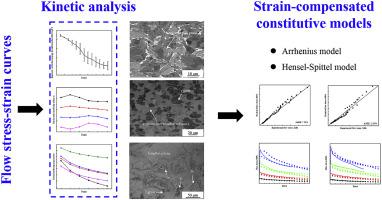当前位置:
X-MOL 学术
›
Prog. Nat. Sci. Mater. Int.
›
论文详情
Our official English website, www.x-mol.net, welcomes your
feedback! (Note: you will need to create a separate account there.)
Kinetic analysis and strain-compensated constitutive models of Ti-42.9Al-4.6Nb–2Cr during isothermal compression
Progress in Natural Science: Materials International ( IF 4.8 ) Pub Date : 2020-04-01 , DOI: 10.1016/j.pnsc.2020.02.004 Runrun Xu , Miaoquan Li , Hong Li
Progress in Natural Science: Materials International ( IF 4.8 ) Pub Date : 2020-04-01 , DOI: 10.1016/j.pnsc.2020.02.004 Runrun Xu , Miaoquan Li , Hong Li

|
Abstract The hot deformation behavior of Ti-42.9Al-4.6Nb–2Cr (at. %) was investigated by isothermal compression tests at the deformation temperature range of 1373–1573 K, strain rate range of 0.001–1.0 s−1, up to the strain of 0.69. The flow stress test results of Ti-42.9Al-4.6Nb–2Cr showed negative temperature and positive strain rate sensitivity. Besides, strain had a great effect on the hot deformation behavior of Ti-42.9Al-4.6Nb–2Cr. Kinetic analysis was adopted to assess the hot workability of Ti-42.9Al-4.6Nb–2Cr via apparent activation energy (Q) of hot deformation, strain-rate sensitivity index (m) and strain hardening index (n). The Q value varied from 607.1 ± 0.7 kJ·mol−1 to 512.6 ± 10.8 kJ mol−1 with the increasing of strain from 0.1 to 0.6. The effect of strain on the Q value at the deformation temperatures below 1473 K was mainly related to dynamic recrystallization of γ phase and kinking of γ lamellae, while the Q value at the deformation temperature above 1473 K might be linked to γ→α phase transformation and DRV of α phase. Based on the kinetic analysis, strain-compensated Arrhenius model and Hensel-Spittel model were successfully established to predict the hot workability (flow stress). Average absolute relative errors of established strain-compensated Arrhenius model and Hensel-Spittel model were 7.52% and 11.95%, respectively. Moreover, both established constitutive models can be extrapolated for predicting the flow stress of Ti-42.9Al-4.6Nb–2Cr to larger strain levels.
中文翻译:

等温压缩过程中 Ti-42.9Al-4.6Nb-2Cr 的动力学分析和应变补偿本构模型
摘要 通过等温压缩试验研究了 Ti-42.9Al-4.6Nb-2Cr (at. %) 的热变形行为,变形温度范围为 1373-1573 K,应变速率范围为 0.001-1.0 s-1,最高可达应变为 0.69。Ti-42.9Al-4.6Nb-2Cr 的流动应力测试结果显示负温度和正应变速率敏感性。此外,应变对 Ti-42.9Al-4.6Nb-2Cr 的热变形行为有很大影响。采用动力学分析方法通过热变形表观活化能 (Q)、应变速率敏感指数 (m) 和应变硬化指数 (n) 评估 Ti-42.9Al-4.6Nb-2Cr 的热加工性。随着应变从 0.1 增加到 0.6,Q 值从 607.1 ± 0.7 kJ·mol-1 变化到 512.6 ± 10.8 kJ mol-1。变形温度低于1473 K时应变对Q值的影响主要与γ相的动态再结晶和γ片晶的扭结有关,而变形温度高于1473 K时的Q值可能与γ→α相变有关和 α 相的 DRV。基于动力学分析,成功建立了应变补偿Arrhenius模型和Hensel-Spittel模型来预测热加工性(流动应力)。建立的应变补偿Arrhenius模型和Hensel-Spittel模型的平均绝对相对误差分别为7.52%和11.95%。此外,两个已建立的本构模型都可以外推以预测 Ti-42.9Al-4.6Nb-2Cr 的流动应力到更大的应变水平。而1473 K以上变形温度下的Q值可能与γ→α相变和α相的DRV有关。基于动力学分析,成功建立了应变补偿Arrhenius模型和Hensel-Spittel模型来预测热加工性(流动应力)。建立的应变补偿Arrhenius模型和Hensel-Spittel模型的平均绝对相对误差分别为7.52%和11.95%。此外,两个已建立的本构模型都可以外推以预测 Ti-42.9Al-4.6Nb-2Cr 的流动应力到更大的应变水平。而1473 K以上变形温度下的Q值可能与γ→α相变和α相的DRV有关。基于动力学分析,成功建立了应变补偿Arrhenius模型和Hensel-Spittel模型来预测热加工性(流动应力)。建立的应变补偿Arrhenius模型和Hensel-Spittel模型的平均绝对相对误差分别为7.52%和11.95%。此外,两个已建立的本构模型都可以外推以预测 Ti-42.9Al-4.6Nb-2Cr 的流动应力到更大的应变水平。建立的应变补偿Arrhenius模型和Hensel-Spittel模型的平均绝对相对误差分别为7.52%和11.95%。此外,两个已建立的本构模型都可以外推以预测 Ti-42.9Al-4.6Nb-2Cr 的流动应力到更大的应变水平。建立的应变补偿Arrhenius模型和Hensel-Spittel模型的平均绝对相对误差分别为7.52%和11.95%。此外,两个已建立的本构模型都可以外推以预测 Ti-42.9Al-4.6Nb-2Cr 的流动应力到更大的应变水平。
更新日期:2020-04-01
中文翻译:

等温压缩过程中 Ti-42.9Al-4.6Nb-2Cr 的动力学分析和应变补偿本构模型
摘要 通过等温压缩试验研究了 Ti-42.9Al-4.6Nb-2Cr (at. %) 的热变形行为,变形温度范围为 1373-1573 K,应变速率范围为 0.001-1.0 s-1,最高可达应变为 0.69。Ti-42.9Al-4.6Nb-2Cr 的流动应力测试结果显示负温度和正应变速率敏感性。此外,应变对 Ti-42.9Al-4.6Nb-2Cr 的热变形行为有很大影响。采用动力学分析方法通过热变形表观活化能 (Q)、应变速率敏感指数 (m) 和应变硬化指数 (n) 评估 Ti-42.9Al-4.6Nb-2Cr 的热加工性。随着应变从 0.1 增加到 0.6,Q 值从 607.1 ± 0.7 kJ·mol-1 变化到 512.6 ± 10.8 kJ mol-1。变形温度低于1473 K时应变对Q值的影响主要与γ相的动态再结晶和γ片晶的扭结有关,而变形温度高于1473 K时的Q值可能与γ→α相变有关和 α 相的 DRV。基于动力学分析,成功建立了应变补偿Arrhenius模型和Hensel-Spittel模型来预测热加工性(流动应力)。建立的应变补偿Arrhenius模型和Hensel-Spittel模型的平均绝对相对误差分别为7.52%和11.95%。此外,两个已建立的本构模型都可以外推以预测 Ti-42.9Al-4.6Nb-2Cr 的流动应力到更大的应变水平。而1473 K以上变形温度下的Q值可能与γ→α相变和α相的DRV有关。基于动力学分析,成功建立了应变补偿Arrhenius模型和Hensel-Spittel模型来预测热加工性(流动应力)。建立的应变补偿Arrhenius模型和Hensel-Spittel模型的平均绝对相对误差分别为7.52%和11.95%。此外,两个已建立的本构模型都可以外推以预测 Ti-42.9Al-4.6Nb-2Cr 的流动应力到更大的应变水平。而1473 K以上变形温度下的Q值可能与γ→α相变和α相的DRV有关。基于动力学分析,成功建立了应变补偿Arrhenius模型和Hensel-Spittel模型来预测热加工性(流动应力)。建立的应变补偿Arrhenius模型和Hensel-Spittel模型的平均绝对相对误差分别为7.52%和11.95%。此外,两个已建立的本构模型都可以外推以预测 Ti-42.9Al-4.6Nb-2Cr 的流动应力到更大的应变水平。建立的应变补偿Arrhenius模型和Hensel-Spittel模型的平均绝对相对误差分别为7.52%和11.95%。此外,两个已建立的本构模型都可以外推以预测 Ti-42.9Al-4.6Nb-2Cr 的流动应力到更大的应变水平。建立的应变补偿Arrhenius模型和Hensel-Spittel模型的平均绝对相对误差分别为7.52%和11.95%。此外,两个已建立的本构模型都可以外推以预测 Ti-42.9Al-4.6Nb-2Cr 的流动应力到更大的应变水平。











































 京公网安备 11010802027423号
京公网安备 11010802027423号